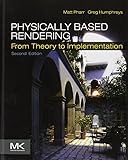Found in 7 comments on Hacker News
falcolas · 2015-07-13
· Original
thread
If you're interested in this topic, you may want to check out the "Physically Based Rendering" book[1]. It's basically a college text book (and priced accordingly) but it walks through the steps to build a fully functional (and fairly performant) ray tracing engine in C++. As a bonus, the code is BSD licensed, and up on github[2].
It's been great to go through it so far; I'm re-writing the renderer in a different language to help with the learning, I can't recommend it enough.
[1]http://www.amazon.com/Physically-Based-Rendering-Second-Impl... [2] https://github.com/mmp/pbrt-v2
tomjakubowski · 2014-12-31
· Original
thread
You can take it up with these guys.
http://www.amazon.com/Physically-Based-Rendering-Second-Edit...
reedlaw · 2014-10-14
· Original
thread
I suggest taking a look at Physically Based Rendering [1]. It goes through an advanced rendering system in a literate coding style. That is, the physical explanations are interspersed with the code of an open source renderer [2]. I'm not sure how it compares with this Disney renderer, but it should go a long way towards demystifying how these things work.
1. http://www.amazon.com/Physically-Based-Rendering-Second-Edit...
yuriks · 2014-07-20
· Original
thread
If you're interested in ray/path tracing or photorealistic rendering at all I would seriously recommend Physically Based Rendering[1]. It's probably one of the most satisfying book purchases I've made. The authors go through every aspect of implementing a quality path tracer: image sampling, surface shading models, statistics and integration methods, intersection testing and acceleration and more. It's an absolute treasure trove of information. (Be prepared to do a lot of math.)
[1] http://www.amazon.com/Physically-Based-Rendering-Second-Impl...
mixedbit · 2014-01-12
· Original
thread
Here are few examples of great 1000+ pages books with lots of code. Though reading them is much more effort than reading a self-help book:
http://www.amazon.com/Programming-Environment-Addison-Wesley...
http://www.amazon.com/TCP-IP-Illustrated-Implementation-Vol/...
http://www.amazon.com/Physically-Based-Rendering-Second-Edit...
defdac · 2013-09-01
· Original
thread
"Physically based rendering" have a second newer edition: http://www.amazon.com/Physically-Based-Rendering-Second-Edit...


These books discuss performant (and sometimes complex) C++ code - in the domain of computer graphics.
http://www.amazon.com/Physically-Based-Rendering-Second-Edit...
http://www.amazon.com/Real-Time-Collision-Detection-Interact...
About how to use the new threading standard: https://www.manning.com/books/c-plus-plus-concurrency-in-act...